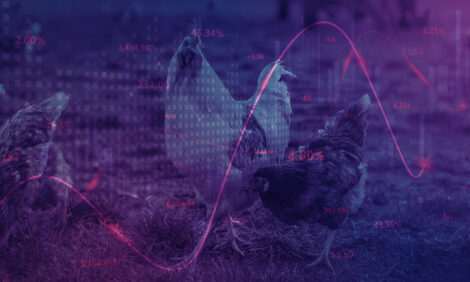



Poultry Outlook Report - August 2004
By U.S.D.A., Economic Research Service - This article is an extract from the August 2004: Livestock, Dairy and Poultry Outlook Report, highlighting Global Poultry Industry data. The report indicates that Broiler meat production is up slightly whilst turkey production falls.
Broiler production during the first half of 2004 was 16.7 billion pounds, up 4.0 percent from the same period in 2003. Broiler meat production during the second half of 2003 is expected to be higher than during the same period in 2003, as broiler companies respond to the stronger prices seen over the first several months of 2004.
|
Composite Broiler Price
Percent change from previous month 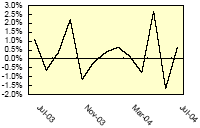
|
Wholesale table egg prices (NY grade A large) in the second quarter of 2004 averaged about 80 cents a dozen, 35 cents lower than the previous quarter, but 6 cents higher than last year. Prices reached a historical monthly average of 123 cents a dozen in March, but dropped rapidly to 74 cents a dozen in May. Table egg production in the second quarter of 2004 rose 2.9 percent over a year earlier. Wholesale prices for all of 2004 are expected to average 89-91 cents a dozen compared with 88 cents in 2003. In 2005, egg prices are expected to average 80-87 cents per dozen.
Broiler Production Increases by 4 Percent
|
Weekly Broiler Slaughter
Percent change from last year 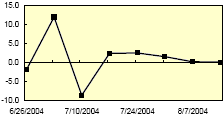
|
Over the first half of 2004, the number of broilers slaughtered was 4.3 billion, up 3.3 percent from the same period in 2003. Average broiler weight at slaughter in the first half of 2004 was 5.22 pounds, up less than 1 percent from the previous year. Broiler meat production during the second half of 2004 is expected to be higher than during the same period in 2003, as broiler companies respond to the stronger prices seen over the first several months of 2004.
While broiler prices have fallen in the most recent months, over the first half of 2004 they were considerably stronger than during the same period in 2003. The number of chicks being placed weekly for growout has averaged 173.9 million over the last 5 weeks (July 10 to August 7). This is a 3.4-percent increase over the same period in 2003. The broiler meat production estimates for the third and fourth quarters are 8.8 and 8.6 billion pounds, respectively. These production levels are 3.9 and 3.8 percent higher than the previous year.
Broiler Exports Down, Forecast is for Gradual Strengthening
Over the first 6 months of 2004, broiler exports have been 2.03 billion pounds,
down nearly 14 percent from the same period in 2003. The chief reasons for the
lower shipments were lower exports to Asian markets (Hong Kong/China, Korea,
and Japan) and to a lesser extent Russia. The decline in exports to these markets
was partially offset by strong growth in shipments to Canada and Mexico, both of
which increased significantly.
Exports to Russia were 618 million pounds in the first half of 2004, 8 percent lower
than the previous year. The decline has come from the impact of restrictions on
broiler products from a number of States where there were Avian Influenza
outbreaks. Another factor was strong prices for leg quarters, especially during the
first quarter of the year. Lower exports to Asian countries (specifically Hong
Kong/China, Korea, and Japan) have resulted from more comprehensive restrictions
on broiler imports. Poultry shipments to Mexico have increased by almost 21
percent over the first half of 2004. With this increase and the strong decreases in
shipments to the Hong Kong/China market, Mexico is likely to be the second
largest market (after Russia) for broiler products in 2004.
The forecast for U.S. broiler exports over the second half of 2003 is for shipments
of 2.3 billion pounds, a decline of 12 percent from the previous year. The two
major factors influencing exports in the second half of 2004 will be if China reduces
its restrictions on U.S. products and the impact of lower prices for such exportoriented
products as leg quarters. With lower prices than in the first half of 2004,
the quantity of product shipped is expected to gradually increase. However, even
though the quantity of product shipped over the first half of 2004 was down, the
total value of those products was up 19 percent from the previous year.
Turkey Production Falls in First-Half 2004
|
Retail Turkey Price
Percent change from previous month 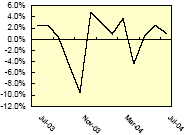
|
The forecast for the second half of 2004 is for a continued decline in production compared with the previous year. The number of pullets placed for growout during the first 6 months of 2004 totaled 142 million, down 4.9 percent from the same period in 2003.
One bright spot is that the lower production has resulted in higher prices, especially for whole birds. In July, the price of 8-16 pound hens in the Eastern market was 71 cents a pound, up 22 percent from a year earlier. With lower production forecast for the remainder of 2004 and with lower stocks as of the end of June, wholesale prices for whole birds are expected to remain above their year-earlier levels through the end of 2004.
Turkey Exports Fall by 19 Percent
|
Weekly Turkey Slaughter
Percent change from last year 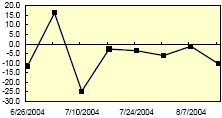
|
The decline in Asian shipments was partially offset by higher exports to Russia and a small gain in shipments to Mexico, the largest market. Shipments to Mexico are expected to gradually strengthen over the second half of 2004 with the lifting of restrictions on exports from specific areas in the United States.
As with broiler exports, even though turkey shipments over the first half of 2004 were down, the total value of these exports rose strongly to $123 million, an increase of 17 percent from a year earlier.
Egg Prices Moderate
Wholesale table egg prices (NY grade A large) in the second quarter of 2004
averaged nearly 80 cents a dozen, 35 cents lower than the previous quarter, but 6
cents higher than last year. Prices reached a historical monthly average of 123
cents a dozen in March, but dropped rapidly to 74 cents a dozen in May. Table egg
production in the second quarter of 2004 rose 2.9 percent over a year earlier and
prices declined seasonally after Easter. The sharp price decline combined with
rising feed costs (corn and soybean meal prices) have substantially squeezed
producer’s returns. However, corn and soybean meal prices have moderated in the
third quarter. Wholesale prices for all of 2004 are expected to average 89-91 cents a
dozen compared with 88 cents in 2003. In 2005, egg prices are expected to average
80-87 cents per dozen.
Likewise, retail egg prices dropped to $1.42 per dozen in the second-quarter of
2004 from $1.59 per dozen in the previous quarter. For all of 2004, retail egg prices
are expected to average in the mid $1.40s per dozen, which would be a record
annual high. Retail egg prices may decline slightly in 2005.
In 2004, table egg production is expected to increase nearly 2 percent over last year,
due to the buildup of the laying flocks. The number of egg-type layers increased by
more than 2 million layers over the previous quarter. During June 2004, egg-type
layers were 282.7 million, about 7.6 million more than a year ago and the largest
inventory of egg-type layers since December 2002.
Total U.S. egg production in 2004, table and hatching, is expected to rise to nearly
7.4 billion dozen, or 1.8 percent over 2003. Table eggs are expected to account for
about 85 percent of total production in 2004. Hatching egg production in 2004 is
expected to rise by 1 percent, reflecting higher broiler production. In 2005, total egg
production is expected to rise slightly over 1 percent.
During the second-quarter of 2004, the quantity of eggs going to the breaking
market rose 9.7 percent compared with the first-quarter, due mainly to declining
shell-egg prices. This trend will most likely continue, resulting in an increase of
about 5 percent in eggs broken this year.
In the second-quarter of 2004, U.S. egg exports were 38.1 million dozen, up
substantially from only 23.2 during the first quarter. The increase is mainly due to
recovery of most U.S. flocks from outbreaks of Avian Influenza in early 2004 and
restrictions imposed by many countries on U.S. eggs and egg products. With bans
lifted, egg exports are expected to resume their normal stage.
Links
For more information view the full Livestock, Dairy and Poultry Outlook - August 2004 (pdf)Source: Livestock, Dairy and Poultry Outlook - U.S. Department of Agriculture, Economic Research Service - August 2004







